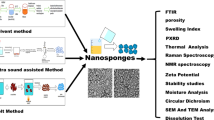Abstract
Molsidomine is one of the sydnonimine class of antianginal drugs that due to its structure exhibits both dipolar nature and aromatic properties. To select efficient carrier for the drug, unmodified and modified mesoporous silica materials were synthesized using phenyltriethoxysilane and 3-aminopropyltriethoxysilane via cocondensation and grafting routes. Synthesis of the mesoporous silica materials via cocondensation was carried out in the presence of D-glucose as pore-forming agent. Equilibrium isotherms for the adsorption of mesoionic compound molsidomine on the mesoporous silica materials were analyzed by the Langmuir, Freundlich, Redlich-Peterson and Langmuir–Freundlich (Sips) models. Langmuir model is found to be the best to explain the equilibrium data. Comparative study of the adsorption properties of the unmodified and modified mesoporous silica materials demonstrated that the phenyl-modified silica materials are the most efficient adsorbents for molsidomine. They exhibit the highest adsorption capacity and affinity in relation to the mesoionic compound.












Similar content being viewed by others
REFERENCES
M. Vallet-Regi, F. Balas, and D. Acros: Mesoporous materials for drug delivery. Angew. Chem. Int. Ed. 46, 7548 (2007).
I.I. Slowing, J.L. Vivero-Escoto, C.W. Wu, and V.S-Y. Lin: Mesoporous silica nanoparticles as controlled release drug delivery and gene transfection carriers. Adv. Drug Delivery Rev. 60, 1278 (2008).
S.P. Rigby, M. Fairhead, and C.F. van der Walle: Engineering silica particles as oral drug delivery vehicles. Curr. Pharm. Des. 14, 1821 (2008).
B.V. Badami: Mesoionic compounds. An unconventional class of aromatic heterocycles. Resonance 11, 40 (2006).
V.G. Yashunskii and L.E. Kholodov: The chemistry of sydnone imines. Russ. Chem. Rev. 49, 28 (1980).
B. Streel, A. Ceccato, C. Peerboom, C. Zimmer, R. Sibenaler, and P. Maes: Determination of molsidomine and its active metabolite in human plasma using liquid chromatography with tandem mass spectrometric detection. J. Chromatogr. A 819, 113 (1998).
P. Luliński and D. Maciejewska: Examination of imprinting process with molsidomine as a template. Molecules 14, 2212 (2009).
R.K. Iler: The Chemistry of Silica (Wiley, New York, 1979), p. 245.
J. Kim, P. Seidler, L.S. Wan, and C. Fill: Formation, structure, and reactivity of amino-terminated organic films on silicon substrates. J. Colloid Interface Sci. 329, 114 (2009).
Y. Wei, J. Xu, H. Dong, J.H. Dong, K. Qiu, and S.A. Jansen-Varnum: Preparation and physisorption characterization of D-glucose-templated mesoporous silica sol-gel materials. Chem. Mater. 11, 2023 (1999).
H. Dong: Organic-inorganic hybrid mesoporous silica materials and their application as host matrix for protein molecules. Ph.D. Thesis, Drexel University, Philadelphia, PA, 2002.
S-W. Song, K. Hidajat, and S. Kawi: Functionalized SBA-15 materials as carriers for controlled drug delivery: influence of surface properties on matrix-drug interactions. Langmuir 21, 9568 (2005).
G. Wang, A.N. Otuonye, E.A. Blair, K. Denton, Z. Tao, and T. Asefa: Functionalized mesoporous materials for adsorption and release of different drug molecules: A comparative study. J. Solid State Chem. 182, 1649 (2009).
L. Yang, S. Weng, J.R. Ferraro, and J. Wu: Far infrared study of some mono- and disaccharides. Vib. Spectrosc. 25, 57 (2001).
R.G. Zhbankov, V.M. Andrianov, C. Ratajczak, and M. Marchewka: Vibrational spectra and stereochemistry of mono- and polysaccharides. II. D-glucose and D-galactose α-anomers. Glucitol. Galactitol. Russ. J. Struct. Chem. 36, 430 (1995).
R.C.T. Slade, C.M. Bambrough, and R.T. Williams: An incoherent inelastic neutron scattering investigation of the vibrational spectrum of phenyl-modified (C6H5–) mesoporous silica and its variations in the presence of sorbed benzene (C6H6) and of sorbed deuteriobenzene (C6D6). Phys. Chem. Chem. Phys. 4, 5394 (2002).
N. Kitadai, T. Yokoyama, and S. Nakashima: ATR-IR spectroscopic study of L-lysine adsorption on amorphous silica. J. Colloid Interface Sci. 329, 31 (2009).
K.S.N. Sing, D.H. Everett, R.A.W. Haul, L. Moscou, R.A. Pierotti, J. Rouquerol, and T. Siemieniewska: Reporting physisorption data for gas/solid systems with special reference to the determination of surface area and porosity (Recommendations 1984). Pure Appl. Chem. 57, 603 (1985).
J.M. Rosenholm and M. Lindén: Towards establishing structure–activity relationships for mesoporous silica in drug delivery applications. J. Controlled Release 128, 157 (2008).
M.A. Hughes: The structure-function relationship of silica polyamine composites. Ph.D. Thesis, The University of Montana, Missoula, MT, 2007.
Z. Aksu, A. Idil Tatli, and Ö. Tunc: A comparative adsorption/biosorption study of acid blue 161: Effect of temperature on equilibrium and kinetic parameters. Chem. Eng. J. 142, 23 (2008).
Z. Chen, D. Pierre, H. Hea, S. Tanc, C. Pham-Huyd, H. Honga, and J. Huang: Adsorption behavior of epirubicin hydrochloride on carboxylated carbon nanotubes. Int. J. Pharm. 405, 153 (2011).
Z. Liu, A.C. Fan, and K. Rakhra: Supramolecular stacking of doxorubicin on carbon nanotubes for in vitro cancer therapy. Angew. Chem. Int. Ed. 121, 7804 (2009).
Q. Hu, J.J. Li, Z.P. Hao, L.D. Li, and S.Z. Qiao: Dynamic adsorption of volatile organic compounds on organofunctionalized SBA-15 materials. Chem. Eng. J. 149, 281 (2009).
D. Brühwiler: Postsynthetic functionalization of mesoporous silica. Nanoscale 2, 887 (2010).
A. Darga, J. Kecht, and T. Bein: Probing the intrapore surface of phenyl-substituted nanoscale mesoporous silica piezoelectric sorption measurements in thin films. Langmuir 23, 12915 (2007).
S.K. Parida, S. Dash, S. Patel, and B.K. Mishra: Adsorption of organic molecules on silica surface. Adv. Colloid Interface Sci. 121, 77 (2006).
Author information
Authors and Affiliations
Corresponding author
Rights and permissions
About this article
Cite this article
Alyoshina, N., Parfenyuk, E. Effect of surface properties of mesoporous silica on adsorption of mesoionic compound molsidomine. Journal of Materials Research 27, 2858–2866 (2012). https://doi.org/10.1557/jmr.2012.329
Received:
Accepted:
Published:
Issue Date:
DOI: https://doi.org/10.1557/jmr.2012.329




